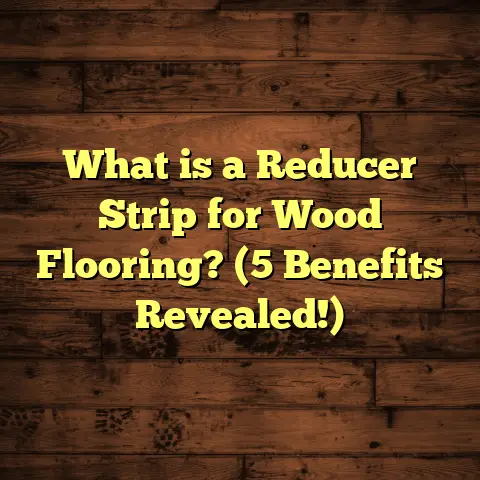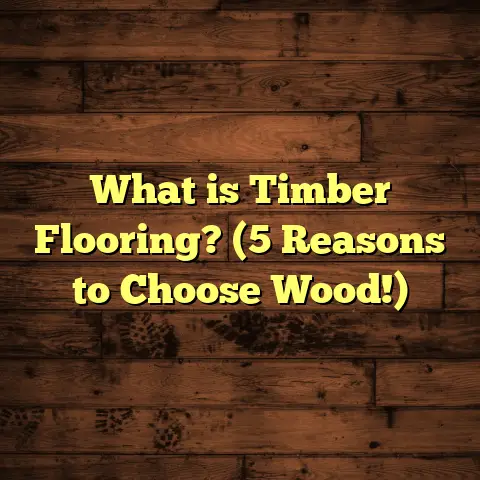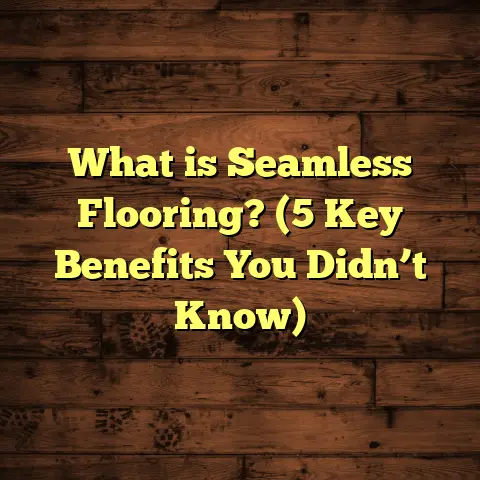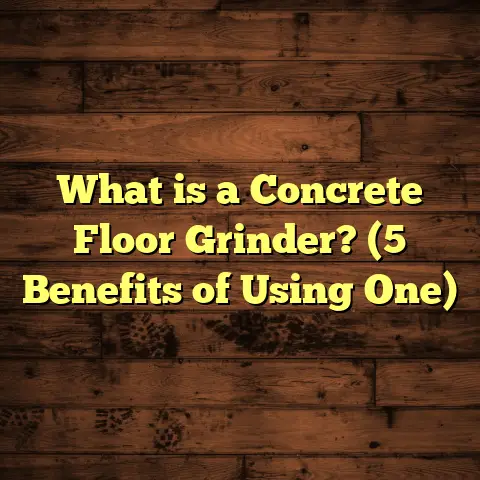What is Hardwood Veneer Flooring? (5 Benefits You Didn’t Know)
I want to share with you a story from a recent project that perfectly captured the magic hardwood veneer flooring can bring into a home. When I first walked into the house, the floors were dull, scratched, and just plain tired. The owners were frustrated because they wanted the classic warmth of wood but couldn’t afford full hardwood. After we installed hardwood veneer flooring, the transformation was incredible—the space suddenly felt warm, inviting, and elegant. It was like the entire house had a fresh story to tell.
That experience stuck with me because it showed me firsthand how this flooring choice can give homeowners a beautiful wood floor without the usual headaches of solid hardwood. If you’ve ever wondered what hardwood veneer flooring is and why so many people are choosing it, let me give you the lowdown from my own experience. I’ll share five benefits you probably didn’t know about and some helpful tips if you’re thinking about going this route.
What Is Hardwood Veneer Flooring?
Hardwood veneer flooring is a type of engineered wood flooring that features a thin layer of real hardwood on top of a core made from plywood, high-density fiberboard (HDF), or medium-density fiberboard (MDF). This thin hardwood layer—called the veneer—is typically around 1-3 millimeters thick, which is much thinner compared to solid hardwood planks.
Instead of a plank made entirely from solid wood, hardwood veneer flooring is like a sandwich: real wood on top and more stable materials underneath. This structure helps reduce expansion and contraction caused by humidity changes, making it more stable than solid hardwood in areas with fluctuating moisture levels.
The Layers Explained
To break it down further, here’s what you’ll find in a typical hardwood veneer plank:
- Top Layer (Veneer): Real hardwood species like oak, maple, cherry, or walnut. This layer gives you the authentic grain, texture, and appearance of wood.
- Core Layer: Usually made from plywood or HDF/MDF, this provides strength and stability. It’s engineered to resist moisture better than solid wood.
- Backing Layer: Sometimes there’s an additional backing layer to balance the plank and provide further dimensional stability.
Because of these layers working together, veneer flooring combines beauty and performance in a way solid wood can struggle to match in certain environments.
Hardwood Veneer vs. Solid Hardwood
You might wonder how hardwood veneer compares to solid hardwood floors. Solid hardwood is milled from a single piece of wood all through its thickness—usually about 18-20 mm thick. This means it can be sanded and refinished many times (sometimes 7-10 times) over its life. But solid wood reacts more dramatically to moisture and temperature changes. It can expand, contract, warp, or cup if conditions aren’t ideal.
Hardwood veneer floors have less wood overall but gain stability from their engineered cores. They don’t swell or shrink as much as solid wood when humidity shifts. That means fewer problems down the line in places like basements or kitchens.
However, because the veneer is thin, refinishing options are limited compared to solid hardwood—usually 2-3 times instead of many more.
How Hardwood Veneer Flooring Is Made
The manufacturing process involves slicing thin sheets of real hardwood from logs—this is the veneer—and gluing them onto the core layers under high pressure. The layers are bonded with strong adhesives designed for durability.
Different slicing methods produce different grain patterns on the veneer:
- Plain Slicing (Flat Cut): Produces cathedral patterns common in traditional oak floors.
- Quarter Slicing (Quarter Cut): Shows straighter grain lines and fewer knots.
- Rotary Peeling: Yields a more varied grain pattern often used in plywood cores.
Knowing these details helps me advise clients on what grain aesthetics they prefer and how that fits their design.
Why Does This Matter?
Because the top layer is real wood, you get all the visual beauty and natural grain patterns that make hardwood so desirable. At the same time, the engineered core underneath provides structural stability, making it less prone to warping or cupping. This means you can install hardwood veneer in rooms where solid hardwood might not hold up well—like basements or over radiant heating systems.
In simple terms, you’re getting the authentic look and feel of hardwood without the full cost or installation challenges associated with solid wood flooring.
A Bit of History
Engineered wood flooring has been around since the early 20th century but gained major popularity in recent decades as manufacturing techniques improved. Hardwood veneer specifically became more accessible as slicing methods advanced to produce consistent thin layers at scale.
This means what once was considered a budget or temporary option has evolved into a premium product that can last decades when installed and maintained properly.
5 Benefits of Hardwood Veneer Flooring You Didn’t Know
1. Cost-Effective Without Sacrificing Quality
Many people think high-quality wood floors have to break the bank. In reality, hardwood veneer flooring often costs 30-50% less than solid hardwood floors. Why? Because less real wood is used overall.
If you’re budgeting for a big flooring project, this can mean big savings. For example, solid oak floors can run anywhere from $8 to $15 per square foot for materials alone, while hardwood veneer floors might be in the $5 to $10 range depending on species and finish.
I use tools like FloorTally to help me get accurate cost estimates based on local labor and material prices. This helps me advise clients realistically and avoid sticker shock.
Besides upfront costs, installation time is usually shorter with veneer flooring due to lighter planks and easier handling—which can also lower labor expenses.
2. Environmentally Friendly
Using thinner layers of real wood means fewer trees are cut down. That’s something I care about personally because sustainable practices are important to me and many homeowners these days.
In fact, studies show engineered wood products can use up to 75% less hardwood than traditional solid planks, which helps conserve natural resources. Plus, many manufacturers source their veneers from responsibly managed forests certified by organizations like FSC (Forest Stewardship Council).
I often recommend clients look for FSC-certified products if sustainability is a priority—it’s reassuring to know your floor comes from well-managed sources.
3. Greater Stability Means Fewer Problems Long-Term
Have you ever heard horror stories about hardwood floors warping or buckling? I have, too—and it’s usually because of moisture issues.
Hardwood veneer flooring handles humidity better than solid wood because its core layers resist expansion and contraction. This makes it a smart choice for kitchens, bathrooms, or even basement rec rooms—places where solid hardwood would struggle.
From my experience, this stability translates into fewer repairs and longer-lasting beauty, saving homeowners money and stress in the long run.
For example, I worked on a coastal home where humidity fluctuated dramatically seasonally. The client had tried solid wood initially but faced ongoing warping issues. Switching to hardwood veneer eliminated those problems completely.
4. Can Be Refinished Several Times
Here’s something many people don’t realize: despite having a thinner top layer than solid hardwood, quality hardwood veneer flooring can still be sanded and refinished multiple times—usually 2-3 times depending on thickness.
This means if your floor gets scratched or worn down over time, it doesn’t mean you have to replace it completely. Refinishing can restore its original shine and extend its life by years.
When I do installations, I always check the veneer thickness to advise clients on how many refinishes they might expect over the floor’s lifetime.
I remember one couple who had their cherry veneer floor refinished twice over 12 years without any issues—they loved how it kept looking fresh without major replacement costs.
5. Wide Range of Styles and Finishes
Hardwood veneer flooring comes in tons of different species—oak, maple, cherry, walnut—and finishes like matte, semi-gloss, or high gloss.
I find this variety really helpful because it allows me to match the floor perfectly with each client’s design vision. Whether you want a rustic farmhouse look or sleek modern vibes, there’s a veneer floor that fits.
Plus, manufacturers often offer exotic species at prices more accessible than solid exotic hardwoods.
I once helped a client pick out Brazilian cherry veneer flooring that looked stunning yet was much easier on their budget than full solid Brazilian cherry planks.
Deep Dive Into Installation: What You Should Know
Installation is where many people get nervous. Hardwood floors are an investment; you want them done right so they last decades.
Subfloor Preparation
Before any flooring goes down, subfloor prep is critical. It must be clean, dry, level within certain tolerances (usually 3/16 inch over 10 feet), and structurally sound.
I always inspect for moisture content—too much moisture can damage any wood floor even engineered ones over time. If moisture is high in concrete slabs (common in basements), I recommend moisture barriers or vapor retarders.
Installation Methods
Hardwood veneer floors can be installed several ways:
- Floating: Planks click together over an underlayment without glue or nails attaching them to the subfloor.
- Glue-down: Adhesive secures planks directly to concrete or plywood subfloors.
- Nail/Staple-down: Mostly used on plywood subfloors; planks are nailed or stapled through the core layer.
Each method has pros and cons:
- Floating floors are faster and easier but sometimes feel less solid underfoot.
- Glue-down creates a very stable feel but takes longer and requires perfect subfloor prep.
- Nail-down gives traditional feel but isn’t suitable for concrete slabs or radiant heated floors.
When I assess jobs, I always consider room use (high traffic?), subfloor type (concrete vs plywood), humidity conditions, and owner preferences before suggesting installation method.
Acclimation Is Key
Hardwood veneer needs time to acclimate before installation—usually about 48-72 hours in the home environment—to adjust moisture levels with surroundings.
Skipping acclimation risks gaps or buckling later because planks expand/contract after installation if not balanced properly beforehand.
Tools & Skills Matter
While floating floors are sometimes DIY-friendly, glue-down and nail-down methods require specialized tools like pneumatic nailers or professional-grade adhesives.
I recommend hiring pro installers unless you have experience because improper installation causes costly issues down the road like squeaks or uneven surfaces.
Maintenance Tips From My Experience That Keep Hardwood Veneer Floors Looking Great
Taking care of hardwood veneer flooring isn’t complicated but does need some routine attention:
Regular Cleaning
Sweeping or vacuuming regularly removes dirt and grit that scratch surfaces. Use soft broom heads or vacuum attachments made for hard floors to avoid damage.
Damp mop occasionally with cleaners designed for wood floors—never soak water as excess moisture can seep into seams causing swelling or damage over time.
Protect From Scratches
Use felt pads under furniture legs and avoid rolling heavy objects directly on floors without protective mats.
Trim pet nails regularly since claws can cause micro-scratches on veneers just like on solid hardwood.
Spot Repairs & Refinishing
Small scratches can be fixed using touch-up kits formulated for your floor’s finish type (e.g., oil-based vs polyurethane).
For deeper wear areas after years of use, refinishing restores appearance but remember your veneer thickness limits how many times sanding can be done safely.
Cost Breakdown: How I Use FloorTally For Accurate Project Planning
Budgeting for flooring projects is one thing clients stress about most. Prices vary widely depending on material quality, labor rates in your area, subfloor condition, and installation method.
FloorTally helps me calculate realistic estimates by pulling local data for materials and labor so I can generate clear budgets quickly with clients’ exact specs: square footage, species choice, installation type.
This tool saves hours compared to calling multiple suppliers or contractors separately—it consolidates everything in one place including waste factor adjustments so we order just enough material without costly overruns or shortages.
Because I use FloorTally early in project planning stages:
- Clients know what to expect financially upfront
- We avoid surprises mid-job
- I get more trust since estimates are data-driven
Case Studies From My Projects: Real-Life Examples of Hardwood Veneer Flooring Success
Coastal Home With Humidity Challenges
Client: Family living near ocean with high seasonal humidity swings
Problem: Solid oak floor warped badly within first year
Solution: Installed 3mm thick oak veneer flooring glued down over plywood subfloor
Outcome: Zero warping issues after 24 months; floor maintained original smooth look despite humidity
Lesson: Veneer’s engineered core beats solid wood stability in moist environments
Renovation On A Budget
Client: Young couple wanted upgraded floor but modest budget
Problem: Solid walnut too expensive; laminate felt cheap
Solution: Chose mid-range walnut veneer flooring installed floating
Outcome: Beautiful authentic look within budget; installation took only 2 days; refinished once after 7 years
Lesson: Veneer offers balance between quality and affordability
High-Traffic Commercial Space
Client: Boutique retail store needing durable stylish floor
Problem: Needed scratch resistant surface with natural wood appeal
Solution: Selected oak veneer with aluminum oxide finish for enhanced wear resistance
Outcome: Floor handled heavy foot traffic for over 5 years with minimal wear
Lesson: Finishes combined with quality veneer create resilient flooring
Frequently Asked Questions About Hardwood Veneer Flooring
Q: Can I install hardwood veneer flooring myself?
A: Some click-lock floating options are DIY-friendly if you have basic carpentry skills. But glue-down/nail-down installations require professional tools & expertise for best results.
Q: How long does hardwood veneer flooring last?
A: Typically 20-30 years depending on wear & maintenance; refinishing extends life further within limits of veneer thickness.
Q: Is hardwood veneer better than laminate?
A: Veneer uses real wood top layers offering authentic appearance & texture; laminate uses photographic layers that don’t age as naturally but often cost less.
Q: How do I clean hardwood veneer floors?
A: Sweep/vacuum regularly; damp mop with pH-neutral cleaner; avoid excess water; use furniture pads & rugs to protect surfaces.
Wrapping Up My Thoughts On Hardwood Veneer Flooring
From my hands-on experience installing dozens of projects over the years,
hardwood veneer flooring stands out as an excellent choice when you want real wood aesthetics combined with greater stability,
cost savings,
and environmental benefits compared to solid wood floors.
It’s not perfect for every situation—its thinner top layer limits refinishing compared to solid hardwood—but for many homeowners,
it strikes a great balance between beauty,
performance,
and price.
If you’re considering new floors,
think about where you live,
how your rooms get used,
and what style fits your design vision before deciding between solid wood,
veneer,
or other materials like laminate or vinyl.
And if budgeting feels overwhelming,
tools like FloorTally helped me save time while keeping costs transparent for my clients—something worth trying if you want clear numbers early on.
Have questions about what’s right for your home? I’m happy to chat anytime!
more case studies,
or cost breakdowns—
just let me know!





